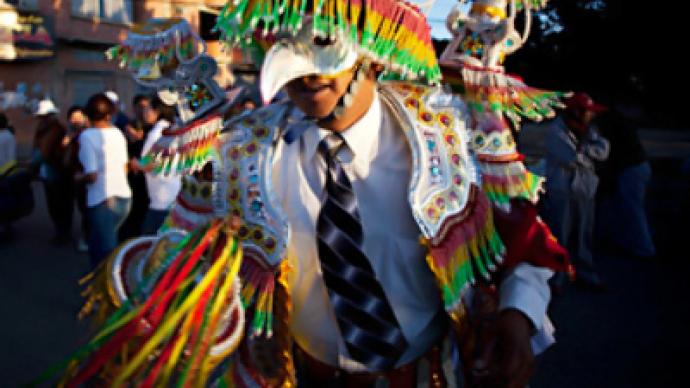Gay Pride hits heights of Bolivia

Indigenous “transformistas” dressed as cholitas dance in Bolivia’s burgeoning El Alto as local people greet the nervous participants of the city’s first gay march with cheers.
“Incredible!” said Zonia Aliaga Poma, a 39-year-old resident of El Alto. La Paz’s satellite town had never seen anything like this.
Where there would usually be a chaotic mass of honking vehicles, gays, lesbians and “tranformistas” performed traditional dances.
This was the first-ever Gay Pride event in El Alto—one of the fastest growing cities in South America.
The parade was led by “transformistas” or transvestites, local indigenous men dressed in the bowler hats and bright, voluminous skirts of cholitas—their female counterparts—dancing the traditional “morenada”.
Behind them, gays and lesbians danced another synchronised favorite, the “kullahuada”. In many ways it was a familiar scene. Bolivians love parades and the spectators would have heard these songs and seen these dances hundreds of times, but never like this.Dancing into the unknown
No one knew how the public would react. There was a heavy presence of slightly bemused-looking policemen in case of problems. However, the dancers faced nothing worse than curiosity from onlookers lining the streets.
It had started nervously. At 5.30 pm, the assembled dancers began drawing attention to themselves before setting off rather shyly into the unknown. As the evening progressed, their numbers grew and so did their confidence.
No discrimination
Roberto Ticona “Vlady”, 32, one of the organizers, said: “We felt a little afraid at the start, but it was great. They applauded us, they cheered us. There was no discrimination.”
Vlady explained that the parade was designed to raise awareness of the gays, lesbians, bisexuals and transgenders among El Alto society.
“This is about our rights and to show that we exist.”
It seemed to have achieved its objective, even if they have not won everyone over. Zonia Aliaga said: “I don’t like this much, but I think that these people are part of society, they have rights and obligations to be known as they are.”
Strictly underground
Recognition by the residents of El Alto is the first step, before acceptance is possible. The gay scene is underground, the two unlicensed gay bars have closed down and toleration at “mixed” nightclubs does not extend to same-sex dancing. Now, gay couples have dates in video salons over glasses of warming red-corn drinks.
Dry and cold, life for El Alto’s more than 650,000 residents is not easy. On the altiplano (high plane) at more than 4,150 metres(13,615ft), the air is thin, while the stinging sun and freezing winds are unremitting.
Unemployment and poverty are high, yet its largely Aymara’s population that continues to spread over the scrub land, with only the spectacular Cordillera Real de los Andes mountains in the distance to hinder El Alto’s growth.
While politically left wing, the culture is conservative and community-based. Yet these tough people accept the parade, and backs Bolivia’s new constitution, which bans discrimination on the grounds of sexual orientation or gender identity.
Brighter future
The parade may have wider implications for gays and lesbians in El Alto. When asked if there were many gay men in El Alto, one of the dancers replied: “Thousands!”
The success of this event suggest future parades will be larger and more confident. Vlady is very positive: “There will be a lot of excitement about the next event, now that people have seen what a success it was this year.”
Jonathan Stibbs for RT












